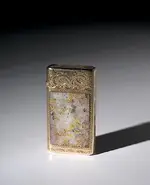AFFADAVIT (COPY)
STATE OF ARIZONA } ss.
County of Maricopa }
BEFORE ME, J Yenerich, a Notary Public in and for the said County, State of Arizona, on this day personally appeared Mr. George Holmes, to me well known, and who, after being duly sworn, deposes and says that the following testimony is true to the best of his knowledge.
My name is George Holmes, often known as “Brownie” Holmes, of Phoenix, Arizona.
My family were Arizona pioneers. My grandfather, R. J. Holmes, Sr., landed at the present site of Yuma in 1847. He was from Holmes County, Mississippi, and graduated from college at Ann Arbor, Michigan, as a geologist and mineralogist. He found gold at La Paz in 1853 nearly ten years before Pauline Weaver’s “discovery”.
My father was R. J. Holmes, Jr., often known as “Dick” Holmes, was born at Old Fort Whipple in 1865. He ranched in Bloody Basin, where Holmes Creek and Holmes Canyon were named for him. He was a civilian packer for the Army, having packed for Al Sieber, among others. He married my mother in 1889 in Tempe. I was born in Phoenix in 1892.
My father knew Jacob Waltz, in later years known as “The Dutchman”. Waltz’ friends were convinced he was operating a hidden gold mine in the Superstition Mountains.
Following heavy rains and floods in February, 1891, in which his adobe fell, Waltz made his home with Mrs. Julia Thomas, a colored woman, near the corner of Jackson and 2nd Avenue in Phoenix. She was married to Emil Thomas, but later married Al Schaffer. Both Mrs. Thomas and Schaffer were religious mystics.
Waltz died in October, 1891, at Mrs. Thomas’ home. On his deathbed he gave my father a miner’s candlebox full of gold ore, which he had under his bed. He also made a lengthy deathbed revelation regarding the history and location of the source of the gold, since called “The Lost Dutchman Mine:. The only people present at this time were Waltz, Dick Holmes, and Gideon Roberts. Mrs. Thomas, delayed in locating a doctor, and the others who claimed to have been present at Waltz’ death, did not enter the scene until later.
Keeping several pieces for specimens, my father sold the remainder of the ore to Goldman & Co., who were general merchants on East Washington Street, receiving about $4,800.00 in the transaction.
One piece of ore was taken to Joe Porterie, an assayer, whose office was on West Washington Street, in the next block west of Goldman’s. The assay showed $110,000.00 per ton in gold, the price of gold then being $20.67 per ounce.
Joe Porterie had been the assayer at the Vulture Mine at Wickenburg during its operation. The rumor that Waltz never had a mine, but high-graded this ore during his employment at the Vulture, was flatly refuted by Porterie, as the ore in Waltz’ possession was quite different from anything at the Vulture. A man of integrity, Porterie later became constable, deputy sheriff, and Deputy U. S. Marshall.
Of the unsold pieces, my father kept some as specimen ore, and also had jewelry made, consisting of a ring, cufflinks, a stickpin and a stud. These are still in my possession.
Of the ore sold to Goldman & Co., most was cleaned and the gold shipped. To my father’s knowledge, the only other specimen ore kept intact was obtained from Goldman’s by Jimmie Douglas. There were several “James Douglases” in the family, this son being the son of the President of the Phelps-Dodge Co., for whom the town of Douglas, Arizona, was named, and the father of Lew Douglas, the American Ambassador to England under President Truman.
Of the ore which Jimmie Douglas obtained, a gold matchbox was made up and presented to Gus H. Hirschfield. Hirschfield, of whom Leo and Charles Goodman were deeply fond, was a skilled mathematician, who at the time kept books for Goldman’s. A prominent Phoenix businessman, Hirschfield later owned the Palace Saloon, located in the same block as Goldman’s store.
I do not know by whom the presentation was made, nor the identity of the “J.L. & Co.” in the engraved inscription on the matchbox. I can offer a GUESS only.
There was, in San Francisco, a manufacturing jeweler known as John Levy & Co. who, during that period, made jewelry which was sold in the Arizona Territory. Both Levy & Hirschfield were Jewish, and Hirschfield was well known in the early West. This MIGHT POSSIBLY explain the inscription, it being understood this is NOT REPRESENTED AS BEING A FACT.
Hirschfield, a friend of both my father and myself, knew my father to have originally been given the ore by “The Dutchman” Jacob Waltz. Accordingly, he advised Mrs. Hirschfield that, upon his death, the match box was to be given to the Holmes family. My father preceded Mr. Hirschfield in death, and at the time of Mr. Hirschfield’s passing, the matchbox was given to me.
In turn, I have presented the matchbox to my friend, XXXXXXXXXXXXXX XXXXXXXXXXXXX of XXXXXXXXXX, Arizona. This affidavit serves as a statement of its historical authenticity, as well as evidence of ownership by XXXXXXXX.
As a means of identification, the matchbox weighs 48.4 grams, and measures 2.489-in. long, 1.317-in. wide and 0.525-in. thick. It is engraved, bearing the inscription “J. L. & Co. to G. H. H.” It is made with inlays of gold-bearing quartz, with free wire fold stringers varying from .06-in. to .13-in. in width, and which would assay an estimated quarter million dollars per ton.
George Holmes
George Holmes
SUBSCRIBED AND SWORN TO BEFORE ME THS 23rd day of April, A.D. 1969.
J. Yenerich
Notary Public
Maricopa County, Arizona
My commission expires My Commission Expires Aug 30, 1970




